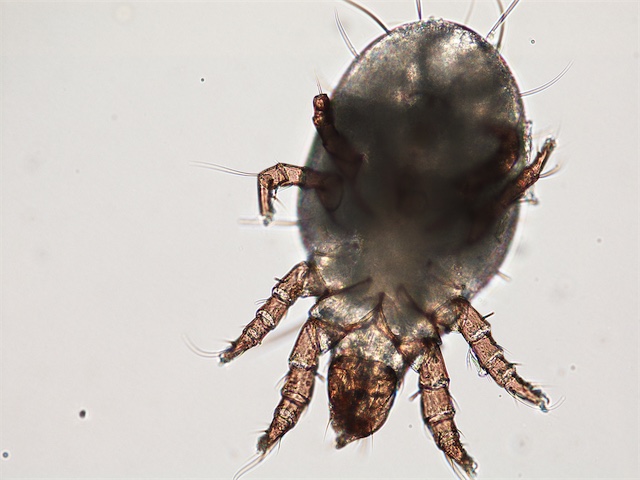Dust mites and allergies
One of the most common culprits of inhalant allergies is dust mites. These sightless, eight-legged arthropods are invisible to the naked eye, but they are common houseguests in temperate to subtropical climates. Although called dust mites they enjoy dining out on human skin and mould. They are a significant cause of allergic rhinitis, allergic asthma and can also be responsible for dermatitis. It is estimated that 30% of us react to them 1.
Because these critters are co-habiting with you, it makes it very difficult to avoid exposure altogether. Aside from relocating to cooler, drier climates, there are some things you can do to reduce their population in your home.
How to reduce dust mite proliferation
Lower Humidity and reduce mould
Dust mites absorb their water from the air, and if the relative humidity is below 50%, they will die of thirst within 5-11 days. Higher humidity also creates optimal growing conditions for mould. Mould is a food source for mites and mould spores can also be an allergen themselves 2.
Dehumidification
In temperate, subtropical and tropical areas the humidity is often well above 50%. This can be controlled by using air conditioners with dehumidification systems or portable dehumidifiers; however, these need to be running continuously to have a real impact, so this may not be a practical or affordable solution.
Fresh air and dust mites don’t mix
- Air the house out as much as possible (2hrs per day is ideal) especially bedrooms and bathrooms to reduce the formation of mould
- Don’t make the bed immediately once you get out but instead pull the covers back and let it air out for an hour or so.
- Treat any mould and/mildew in the house and remove the cause of the damp
- Use extraction fans in bathrooms and kitchens
- Ensure your clothes dryer vents to the outside
- Avoid drying washing in the house
- Avoid having fish tanks in bedrooms
Destroy the dust mite’s cosy living arrangements
Dust mites like to live in carpets and soft furnishings such as pillows, mattresses, curtains and fabric sofa. They seem to thrive best in undisturbed environments like under the bed or clothes drawers. Replacing, protecting and regular cleaning can reduce the impact dust mites will have.
Carpets
The ultimate solution is to replace the carpet with a hard flooring surface such as floorboards or linoleum. However, if this is not possible due to budget or if you are renting you can still get a reduction in dust mite numbers with regular “dust mite busting” cleaning.
Rugs can be washed with the garden hose, detergent and dried in the sun. Laying carpets out in the sun will kill mites, but the allergen (from dead mites and their faecal particles) will still be there.
Steam cleaning needs to be done with steam, not hot water as the hot water wash leaves the carpet damp at the base and provides an ideal environment for house dust mite breeding and feeding.
Invest in a powerful vacuum cleaner with a high-efficiency particulate air (HEPA) filter. The HEPA filter traps the fine particles from the dust mite’s faeces. Vacuum carpets thoroughly once or twice a week and include areas under furniture for the best results. Change the filter and empty the bag/dust container regularly to ensure this doesn’t become a breeding ground for dust mites.
Bedding
The other area where people get the most exposure to dust mites is from their bedding. Most of us spend 8-10 hours in our beds each day, and young children often spend much more. If you are short on cleaning time, focus your efforts on the bedroom.
Mattress and pillow protectors are a worthwhile investment if you have a dust mite allergy. They are readily available and should have a “pore size” of less than 10 microns to ensure the dust mites can’t penetrate them.
Washing
Regular washing of sheets, pillowcases including dust mite protectors are essential. Coldwater washing will remove the allergy protein, but hot water washing (above 55 degrees C) will also kill the dust mites. Dry either in the sun or a clothes dryer on a setting above 55 degrees.
For delicate fabrics soaking adding a capsule of eucalyptus or tea tree essential oil to the washing water can be helpful.
Dusting
Regular dusting is also necessary. Be sure to use a damp cloth to avoid inhaling the dust.
What about diatomaceous earth for dust mites?
Diatomaceous earth is the powdered, fossilised remains of algae. Many blogs advocate it as a natural pest control method for killing dust mites. In theory, it works by stopping the dust mites from getting water from the atmosphere, and they dehydrate. I was not able to locate any studies on this method so I can’t comment on how effective it might be. However, if you do decide to give it a go, it would be worthwhile wearing a facemask to prevent you from inhaling the fine powder into your lungs.
What kind of benefit?
It does sound like a lot of effort. However, research has shown that using these cleaning methods can reduce dust mites by half 2. Combined with other treatments this could result in fewer allergy symptoms and improved health.
If you liked this you might also enjoy:
Your 3-step natural approach to give hay fever the flick
Herbal eyewash for conjunctivitis
References:
- Arlian LG, Platts-mills TAE. The biology of dust mites and the remediation of mite allergens in allergic disease. J Allergy Clin Immunol. 2001;107(3):406-413. doi:10.1067/mai.2001.113670.
- Linneberg A, Hernandez D, Rojas F De, Virchow JC, Demoly P, Kingdom U. Respiratory allergy caused by house dust mites : What do we really know ? J Allergy Clin Immunol. 2015;136(1):38-48. doi:10.1016/j.jaci.2014.10.012.

Need help with your health?
Norelle Hentschel is an experienced Naturopath with a clinic in Stones Corner, Brisbane who enjoys supporting her clients to reach their health goals.
Want more articles like this?
Receive a monthly digest of natural health information to help you become “health” sufficient!
PS. Your inbox real estate is precious, and we will never annoy you with sales pitches or share your details with anyone else. One email a month — that’s it.


I knew about the humidity level to keep your home to protect from damp and mould occurring. But I didn’t realise the level at which dust mites would stop living. Thank you for a really interesting article.